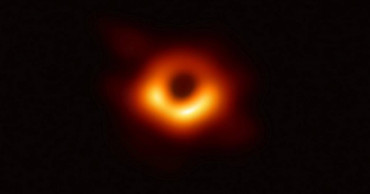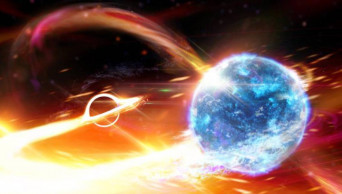Black hole
Astronomers capture 1st image of Milky Way's huge black hole
The world's first image of the chaotic supermassive black hole at the center of our Milky Way galaxy doesn't portray a voracious cosmic destroyer but what astronomers Thursday called a “gentle giant" on a near-starvation diet.
Astronomers believe nearly all galaxies, including our own, have these giant black holes at their bustling and crowded center, where light and matter cannot escape, making it extremely hard to get images of them. Light gets bent and twisted around by gravity as it gets sucked into the abyss along with superheated gas and dust.
The colorized image unveiled Thursday is from an international consortium behind the Event Horizon Telescope, a collection of eight synchronized radio telescopes around the world. Getting a good image was a challenge; previous efforts found the black hole too jumpy.
"It burbled and gurgled as we looked at it," the University of Arizona's Feryal Ozel said.
She described it as a “gentle giant” while announcing the breakthrough along with other astronomers involved in the project. The picture also confirms Albert Einstein's general theory of relativity: The black hole is precisely the size that Einstein's equations dictate. It is about the size of the orbit of Mercury around our sun.
Black holes gobble up galactic material but Ozel said this one is “eating very little.” It's the equivalent to a person eating a single grain of rice over millions of years, another astronomer said.
Also read: Earth given 50-50 chance of hitting key warming mark by 2026
“Pictures of black holes are the hardest thing to think about,” said astronomer Andrea Ghez of the University of California, Los Angeles. She wasn't part of the telescope team bu t earned a Nobel Prize for the discovery of the Milky Way's black hole in the 1990s.
She said the image of “my baby” is exactly how it should be — an eerie-looking orange-red ring with utter blackness in the middle.
Scientists had expected the Milky Way's black hole to be more violent, especially since the only other image from another galaxy shows a far bigger and more active black hole.
“It is the cowardly lion of black holes,” said project scientist Geoffrey C. Bower of Taiwan's Academia Sinica Institute of Astronomy and Astrophysics.
Because the black hole “is on a starvation diet” so little material is falling into the center, and that allows astronomers to gaze deeper, Bower said.
The Milky Way black hole is called Sagittarius A (with an asterisk denoting star). It's near the border of Sagittarius and Scorpius constellations and is 4 million times more massive than our sun. Bower said it is probably more typical of what’s at the center of most galaxies, “just sitting there doing very little.”
Also read: US astronaut ends record-long spaceflight in Russian capsule
It is incredibly hot, trillions of degrees, Ozel said.
The same telescope group released the first black hole image in 2019. The picture was from a galaxy 53 million light-years away that is 1,500 times bigger than the one in our galaxy. The Milky Way black hole is much closer, about 27,000 light-years away. A light year is 5.9 trillion miles (9.5 trillion kilometers).
To get the picture, the eight telescopes had to coordinate so closely “in a process similar to everyone shaking hands with everyone else in the room,” said astronomer Vincent Fish of the Massachusetts Institute of Technology.
Astronomers worked with data collected in 2017 to get the new images. The next step is a movie of one of those two black holes, maybe both, Fish said.
The project cost nearly $60 million with $28 million coming from the U.S. National Science Foundation.
Even though it is quieter than expected, the center of the Milky Way is an important place to study, Ghez said.
It's "like an urban downtown, everything is more extreme. It's crowded. Things move fast,” Ghez said in an interview. “We live out in the suburbs (in a spiral arm of the galaxy). Things are calm out here.”
3 years ago
3 scientists win Nobel physics prize for black hole finds
Three scientists won this year's Nobel Prize in physics Tuesday for advancing our understanding of black holes, the all-consuming monsters that lurk in the darkest parts of the universe.
5 years ago
High-speed jet closest to black hole found
Chinese researchers discovered that the low-frequency quasi-periodic oscillations (LFQPOs) above 200 keV in a new black hole originated from the precession of a closest relativistic jet to the black hole.
5 years ago
Spotlight: First image of a black hole named Science's Breakthrough of the Year
The Event Horizon Telescope's image of a supermassive black hole was named on Thursday by the influential U.S. journal Science as 2019's Breakthrough of the Year.
6 years ago
Black hole gobbles up neutron star, causing ripples in space and time
Dhaka, Aug 21 (UNB)- In the same decade when gravitational waves and a neutron star merger have been observed, astronomers have now observed what they believe to be the first detection of a black hole swallowing a neutron star, reports CNN.
6 years ago





